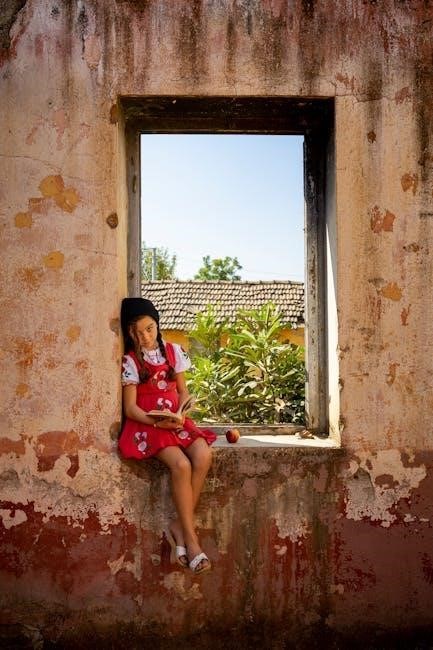Cry, the Beloved Country by Alan Paton is a profound exploration of racial injustice and hope in South Africa. Its enduring relevance and emotional depth make it a timeless classic, with PDF versions widely available for readers worldwide.
Overview of the Novel
Cry, the Beloved Country, written by Alan Paton in 1948, is a poignant novel set in South Africa during the brink of apartheid. It follows Reverend Stephen Kumalo, a Zulu pastor, as he journeys from his rural village of Ndotsheni to Johannesburg in search of his estranged son, Absalom. The story explores themes of racial injustice, poverty, and the disintegration of tribal life, offering a powerful critique of South Africa’s socio-political landscape. Through its emotional depth and vivid portrayal of a divided society, the novel has become a classic of world literature, resonating with readers for its universal themes of hope, loss, and redemption.
Historical Context of the Book
Cry, the Beloved Country is set in 1940s South Africa, a period marked by deep racial divide and socio-political turmoil. Published in 1948, the novel coincided with the formal establishment of apartheid, a system of institutionalized racial segregation enforced by the National Party. Paton’s work captures the widespread suffering and inequality faced by black South Africans, offering a poignant critique of the oppressive policies and their devastating impact on families and communities. The book reflects the nation’s fractured society, portraying the tension between traditional tribal life and the encroaching urbanization and racism that threatened to destroy it.

Background of the Author and Setting
Alan Paton, born in 1903, was a South African author and activist deeply concerned with racial inequality. His novel is set in 1940s South Africa, reflecting the tense transition from rural tribal life to urbanization under apartheid’s shadow.
Alan Paton’s Background and Motivations
Alan Paton, born in 1903 in Natal, South Africa, was a teacher, principal, and writer deeply influenced by his country’s racial tensions. His Christian faith and commitment to social justice shaped his work. Co-founding the South African Liberal Party in 1953, he actively opposed apartheid. Published in 1948, Cry, the Beloved Country reflected his sorrow for South Africa’s divisions and his hope for reconciliation. Paton’s motivations were rooted in exposing racial inequality and advocating for change, blending personal conviction with societal critique to create a timeless narrative of human struggle and redemption.
The Setting of the Novel in South Africa
Cry, the Beloved Country is set in 1946 South Africa, primarily in the rural village of Ndotsheni near Ixopo and the bustling city of Johannesburg. The novel vividly contrasts the serene, traditional Zulu culture of the countryside with the urban chaos and racial divides of the city. This duality underscores the social and economic disparities of the time, reflecting the deepening racial tensions and poverty that plagued pre-apartheid South Africa. The setting serves as a backdrop to explore themes of cultural erosion, urban migration, and the struggle for justice, highlighting Paton’s critique of a fractured society;

Major Themes Explored in the Book
The novel explores themes of racial injustice, hope, redemption, and family ties, set against the backdrop of South Africa’s turbulent pre-apartheid era and social divides.
Racial Injustice and Apartheid
Cry, the Beloved Country vividly portrays the devastating impact of racial injustice and apartheid in South Africa. Paton highlights the systemic oppression faced by black South Africans, such as forced segregation, economic inequality, and limited access to education and opportunities. The novel underscores the moral and social decay caused by these policies, emphasizing the dehumanizing effects on both black and white communities. Through the journey of Stephen Kumalo, Paton illustrates the deep racial divide and the struggle for justice, making the book a powerful critique of apartheid and a call for moral reckoning.
Hope and Redemption in a Troubled Society
Cry, the Beloved Country balances its bleak portrayal of apartheid with a message of hope and redemption. Through Stephen Kumalo’s journey, Paton illustrates the possibility of healing and forgiveness, even amidst societal fragmentation. The novel suggests that while racial divisions and injustice prevail, individual acts of compassion and moral courage can inspire change. Kumalo’s unwavering faith and his son Absalom’s tragic redemption underscore the idea that hope, though fragile, remains a powerful force against despair. Paton’s vision of a unified South Africa, though unattained in his time, offers a enduring message of optimism and resilience.
Family and Community Ties
Cry, the Beloved Country underscores the importance of family and community bonds in a fractured society. Stephen Kumalo’s journey to Johannesburg to find his son Absalom highlights the disintegration of family ties due to urban migration and racial oppression. The novel portrays the tension between traditional communal values and the alienation of city life. Kumalo’s unwavering commitment to his family and his village, Ndotsheni, serves as a counterpoint to the societal chaos. Paton vividly illustrates how the erosion of these bonds exacerbates South Africa’s racial and economic divide, while also showing how community solidarity offers a fragile but vital source of strength and hope.
Key Characters in the Novel
Stephen Kumalo, a devout Zulu pastor, embarks on a poignant journey to find his son Absalom. Absalom Kumalo faces moral struggles, while John Kumalo and Gertrude add depth to the narrative. The tragic death of Arthur Jarvis and the transformation of James Jarvis highlight the novel’s emotional and societal complexity. These characters, central to Paton’s story, are available for readers to explore in the PDF version of Cry, the Beloved Country.
Stephen Kumalo: The Protagonist
Stephen Kumalo is the heart of Cry, the Beloved Country, embodying resilience and moral strength. A humble Zulu pastor, he ventures from rural Ndotsheni to Johannesburg in search of his lost son, Absalom. His journey reveals the deep racial divides and societal decay of pre-Apartheid South Africa. Through Kumalo’s eyes, readers witness the struggle for justice and the enduring power of faith. His story, available in PDF format, highlights Paton’s masterful portrayal of a man torn between tradition and the harsh realities of a fractured world.
Absalom Kumalo: The Son’s Journey
Absalom Kumalo’s journey is marked by turmoil and tragedy, reflecting South Africa’s racial and societal fractures. As Stephen Kumalo’s son, Absalom leaves his village for Johannesburg, where he faces moral decay and criminal entanglements. His imprisonment for murder symbolizes the devastating consequences of a broken system. Despite his flaws, Absalom’s story evokes deep empathy, highlighting the struggle for redemption in a society torn apart by apartheid. His narrative, available in PDF, underscores Paton’s exploration of justice, forgiveness, and the enduring impact of family bonds in a fractured world.
Other Significant Characters
Beyond Stephen and Absalom Kumalo, other characters play pivotal roles in shaping the narrative. Jarvis, a white farmer, embodies redemption and unity, while John Kumalo, Stephen’s brother, represents the complexities of urban ambition. Father Vincent, a compassionate priest, offers spiritual guidance, highlighting themes of faith and hope. These characters, along with others, enrich the story’s emotional and moral depth. Their journeys, intertwined with the Kumalo family’s, provide a broader perspective on South Africa’s societal struggles. The novel’s diverse cast, available in PDF, underscores Paton’s nuanced exploration of human resilience and the quest for justice.

Plot Summary and Structure
Reverend Stephen Kumalo embarks on a poignant journey to Johannesburg to find his son, Absalom. The novel unfolds through his quest, the trial, and its profound aftermath, culminating in resolution and reflection on South Africa’s tumultuous landscape, all beautifully captured in the PDF version.
Journey to Johannesburg
Reverend Stephen Kumalo’s journey to Johannesburg is a pivotal segment in Cry, the Beloved Country; Driven by concern for his son Absalom, Kumalo leaves his rural village of Ndotsheni. The city reveals stark contrasts: wealth and poverty, hope and despair. Kumalo’s experiences highlight the social and racial divides of 1940s South Africa. His search for Absalom exposes him to the harsh realities of urban life, where familial bonds are tested by the city’s unforgiving environment. This journey is masterfully detailed in the PDF version, offering readers a vivid exploration of Paton’s themes.
The Trial and Its Aftermath
The trial of Absalom Kumalo for the murder of Arthur Jarvis is a harrowing climax in Cry, the Beloved Country. Tensions rise as racial divides deepen, and the legal system’s bias is exposed. Absalom’s sentencing to death devastates Stephen Kumalo, highlighting the tragedy of a son’s downfall. The aftermath underscores the novel’s themes of injustice and loss, as Stephen grapples with grief and the moral complexities of his country. The PDF version captures the emotional weight of this pivotal moment, illustrating Paton’s critique of a society fractured by inequality and prejudice.
Resolution and Conclusion
The resolution of Cry, the Beloved Country brings a poignant mix of sorrow and hope. Stephen Kumalo returns to Ndotsheni, grappling with the loss of his son Absalom, who is executed for his crimes. Despite the tragedy, Stephen finds solace in his community and the promise of renewal, symbolized by the birth of his grandson. The novel concludes with a sense of resilience and the enduring possibility of healing, even in a fractured society. The PDF version of the book captures the emotional depth of this conclusion, emphasizing Paton’s message of hope and the potential for redemption amidst suffering.

Symbolism and Biblical References
The title Cry, the Beloved Country reflects a lament for South Africa, echoing a biblical psalm. Paton’s use of symbolism, like Stephen Kumalo’s journey, mirrors Moses’ leadership, emphasizing divine guidance and redemption themes.
Significance of the Title
The title Cry, the Beloved Country is a poignant lament for South Africa, reflecting Paton’s deep sorrow for his nation’s racial divisions. It encapsulates the novel’s central themes of loss, hope, and redemption, evoking a sense of collective grief. The phrase “beloved country” symbolizes a land cherished yet fractured by injustice. Paton’s choice of title underscores the spiritual and emotional struggle of a people divided, while also hinting at the possibility of healing and unity. The title’s biblical resonance adds depth, framing the story within a universal moral framework.
Biblical Themes and Motifs
Cry, the Beloved Country is rich in biblical themes, reflecting Alan Paton’s Christian faith. The novel mirrors the story of the prodigal son through Absalom’s journey, while Stephen Kumalo embodies a prophetic figure, seeking justice and redemption. The land itself is depicted as a desolate, broken world, evoking biblical imagery of a fallen creation. Paton’s use of moral dichotomies—good vs. evil, forgiveness vs. vengeance—underscores the universal spiritual struggle. These motifs resonate deeply, framing the novel as a modern parable that transcends its South African context, offering timeless lessons on morality and compassion.

Writing Style and Narrative Technique
Alan Paton’s lyrical prose and simple yet powerful language create a deeply emotional narrative. His use of parallel storytelling and vivid imagery enhances the novel’s dramatic and moral depth;
Narrative Structure and Style
Alan Paton’s narrative structure in Cry, the Beloved Country blends simplicity with profound emotional depth. The story unfolds through a parallel narrative, juxtaposing the journeys of Stephen Kumalo and James Jarvis. Paton’s lyrical prose and vivid imagery evoke the beauty and sorrow of South Africa, while his use of Christian motifs adds moral resonance. The novel’s non-linear progression builds tension, reflecting the fractured society it portrays. Paton’s writing is both poetic and accessible, creating a universal appeal that transcends cultural boundaries, making the novel a masterpiece of 20th-century literature.
Use of Language and Imagery
Alan Paton’s lyrical prose in Cry, the Beloved Country is marked by vivid imagery that evokes the stark beauty of South Africa. His descriptions of the land, such as “the great red hills,” create a sense of timelessness and connection to the earth. Paton’s language is both poetic and powerful, often contrasting the natural beauty of the countryside with the moral and social ugliness of apartheid. Biblical references and metaphors enrich the narrative, while his use of simple yet profound language underscores themes of redemption and justice. This unique style has made the novel a timeless classic, resonating with readers globally.

Social and Cultural Impact
Cry, the Beloved Country exposed the harsh realities of apartheid, sparking global conversations about racial injustice. Its influence led to significant societal change, making it a banned yet enduring classic.
Influence on Apartheid Discussions
Cry, the Beloved Country played a pivotal role in shaping global perceptions of apartheid. Published in 1948, it coincided with the formalization of apartheid policies, offering a poignant critique of racial segregation. The novel’s vivid portrayal of South Africa’s socio-political turmoil sparked international discussions, highlighting the injustices faced by Black South Africans. Alan Paton’s work not only humanized the struggles of characters like Stephen Kumalo but also challenged the moral legitimacy of apartheid. Its influence extended beyond literature, contributing to the growing resistance against apartheid and inspiring movements for equality and justice both locally and internationally.
Role in Social Change Movements
Cry, the Beloved Country became a catalyst for social change, inspiring movements against apartheid and racial inequality. Its impactful narrative resonated globally, fueling anti-apartheid activism. The novel’s themes of hope and redemption aligned with the aspirations of oppressed communities, making it a symbolic beacon in the fight for justice. By humanizing the struggles of characters like Stephen Kumalo, Paton’s work bridged cultural divides, fostering empathy and solidarity; The book’s influence extended beyond literature, supporting the moral foundation of South Africa’s liberation struggle and contributing to the eventual dismantling of apartheid in the 1990s.
Reception and Reviews
Cry, the Beloved Country received widespread acclaim for its poignant portrayal of racial injustice and emotional depth. Critics praised its universal appeal, making it a bestseller and a classic.
Initial Reception and Reviews
Cry, the Beloved Country was met with immediate acclaim upon its release in 1948. Critics praised its emotional depth and universal themes, hailing it as a powerful exploration of South Africa’s racial divide. The novel resonated globally, becoming a bestseller and cementing Alan Paton’s reputation as a major literary voice. Its vivid portrayal of Stephen Kumalo’s journey and the societal struggles of apartheid struck a chord, earning it widespread critical admiration and a lasting place in world literature.
Modern Significance and Relevance
Cry, the Beloved Country remains a vital read today, offering insights into themes of racial injustice and social inequality. Its exploration of hope amidst turmoil continues to resonate, making it a cornerstone of modern literary studies. The novel’s universal themes of family, morality, and societal conflict ensure its relevance in contemporary discussions on race and justice. Its influence extends beyond literature, inspiring movements for equality and human rights; The availability of PDF versions ensures accessibility, allowing new generations to connect with its timeless message and reflect on its enduring impact.

Adaptations and Interpretations
Cry, the Beloved Country has been adapted into films and stage plays, enriching its cultural impact. Its themes continue to inspire artistic interpretations, ensuring its lasting relevance.
Film and Stage Adaptations
Cry, the Beloved Country has been adapted into films and stage plays, expanding its cultural reach. The 1951 film adaptation, directed by Zoltán Korda, brought the story to the screen, while a 1995 version starred James Earl Jones. Stage productions have also captured the novel’s emotional depth, further cementing its impact. These adaptations have ensured the story remains relevant, resonating with audiences beyond the written word and highlighting its universal themes of justice and redemption.
Cultural and Artistic Interpretations
Cry, the Beloved Country has become a cultural symbol, sparking discussions on apartheid and social justice. Its universal themes of racial injustice and hope resonate globally, transcending South Africa’s borders. The novel’s emotional depth and moral clarity have inspired artistic interpretations, from literature to music, reflecting its enduring relevance. As a PDF, the book remains accessible, ensuring its message continues to influence new generations. Paton’s work is celebrated for its ability to bridge cultural divides, making it a timeless piece of art that challenges and inspires readers worldwide.

Study Resources and Analysis
Cry, the Beloved Country study guides and critical essays provide in-depth analysis of themes, characters, and historical context. PDF versions offer easy access to scholarly interpretations and insights.
Study Guides and Educational Tools
Cry, the Beloved Country study guides and educational tools are widely available, offering insights into themes, characters, and historical context. PDF versions of these resources provide detailed chapter summaries, critical essays, and analysis of Alan Paton’s narrative style. Educational tools also include discussion questions, character maps, and historical background information, making them invaluable for students and educators. These resources enhance understanding of the novel’s exploration of racial injustice, hope, and redemption, while also highlighting its literary significance. They are particularly useful for classroom discussions and deeper analysis of the text’s complex themes.
Critical Analysis and Essays
Critical essays on Cry, the Beloved Country offer deep insights into its themes, characters, and historical context. Scholars analyze the novel’s exploration of racial injustice, hope, and redemption, while also examining Alan Paton’s narrative style. Essays in PDF format are widely available, providing academic perspectives on the book’s moral and political implications. Many focus on the novel’s biblical undertones and its portrayal of South Africa’s tumultuous past. These analyses are invaluable for understanding the novel’s literary significance and its impact on discussions about apartheid and social justice. They also highlight the universal themes that make the book a timeless classic.

Availability and Access
Cry, the Beloved Country is widely available in PDF format on platforms like pdfdrive.cloud and z-lib.org. Published by Charles Scribner’s Sons, New York, it remains accessible since 1948.
PDF and Digital Versions
Cry, the Beloved Country is widely available in PDF and digital formats, accessible through platforms like pdfdrive.cloud and z-lib.org. First published in 1948 by Charles Scribner’s Sons, the novel remains popular in digital formats, allowing readers to engage with its poignant themes of racial injustice and hope. The PDF version is particularly sought after for its convenience, ensuring Alan Paton’s powerful story reaches a modern audience. Its digital availability has made it a staple in academic and personal libraries, maintaining its relevance in discussions on social justice and equality.
Legal Considerations and Copyright
The copyright of Cry, the Beloved Country is held by its publisher, Charles Scribner’s Sons, with rights extending beyond the author’s lifetime. As Alan Paton passed away in 1988, the novel remains under copyright until 2058. While digital versions are widely available, downloading or sharing the book without authorization violates copyright laws. Legal access is ensured through licensed platforms, respecting the intellectual property rights of the author and publisher. Adhering to copyright guidelines supports the preservation of literary works and their continued availability for future generations. Always opt for authorized sources to access this seminal work legally and ethically.
Cry, the Beloved Country stands as a poignant testament to South Africa’s tumultuous past and its universal themes of hope and redemption. Alan Paton’s masterpiece continues to resonate, offering insights into racial injustice and the human spirit. With its rich narrative and moral depth, the novel remains a vital read in both physical and digital formats, including PDF, ensuring its accessibility to modern readers. Paton’s work not only reflects historical struggles but also inspires ongoing conversations about equality and unity, cementing its place in world literature. Its enduring relevance underscores the power of storytelling to transcend time and borders.
